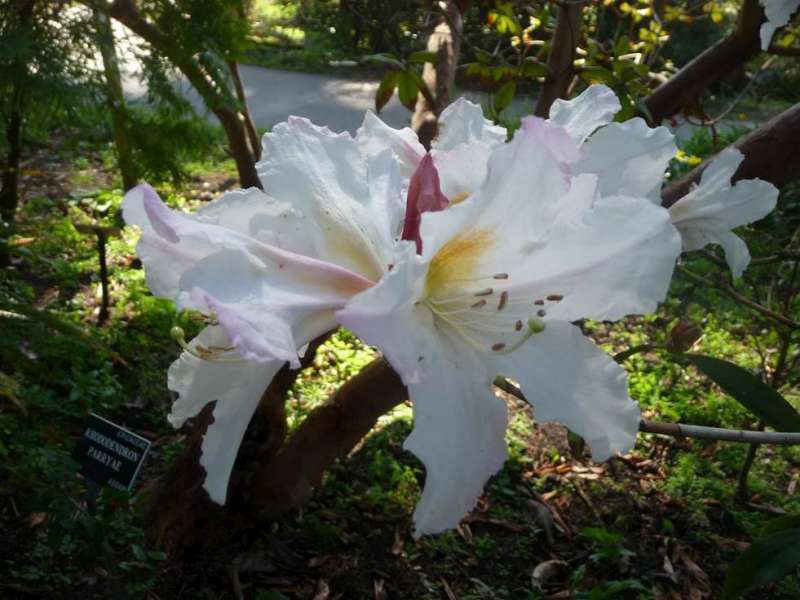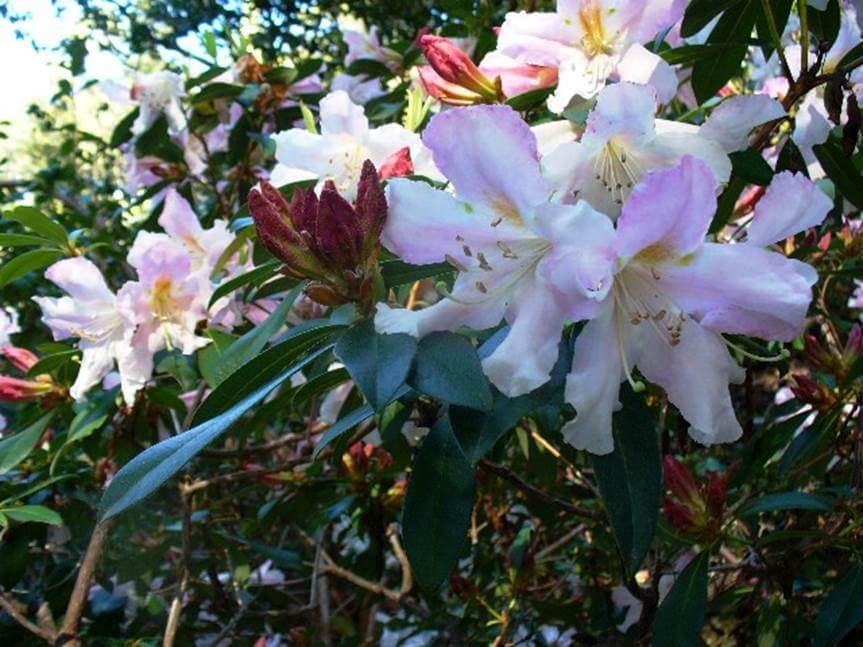Rhododendron parryae
Billeder af Rhododendron parryae
Beskrivelse
R. parryae (Maddenia). En stedsegrøn busk eller lille træ i naturen, nogle gange epifytisk, med en lyserød-lilla, afskallet bark. Bladene er smalt aflange-elliptiske, sub akutte til afrundede og med en mucro i spidsen. Bladoversiden mørkegrøn, og lyser på undersiden, skællet. Bladstilk 1-2 cm lang, skællet. Blomsterne sidder samlet i 3-4 af gangen og dufter. Blomsterbægeret er meget lille, skællende og kort med randhår. Kronen bredt tragtformet, op til 5 cm bred, hvid med en fremtrædende orange-gul plet. De 5 lober er bølgede, let skællende nær midten. Kronrøret let skællende og dunet nær bunden på ydersiden. Støvdragere håredefor neden. Æggestokke tæt skællende; griflen skællet i den nederste halvdel. Ikke hårdfør, frostfølsom.
Hans Eiberg
Ikke i ARS og Flora of China
RBGE Herbarium; R. parryae (no data)
Trees and Shrubs
Shrub, 1.5–3 m, sometimes epiphytic; young shoots with or without setae. Leaves 6–14 × 3–6 cm, elliptic to oblong-elliptic, apex acuminate to rounded, margin lacking setae, upper surface with impressed midrib; lower surface with unequal brown scales that are 1–2× their own diameter apart. Flowers 3–5, in a loose terminal inflorescence, scented; calyx minute, ciliate; corolla white with a yellowish blotch at base, funnel-shaped, 70–85 mm, outer surface with scales throughout, pilose at base; ovary scaly, tapering into the style that is scaly below. Flowering May. Royal Horticultural Society (1997)
Distribution India Arunachal Pradesh
Habitat 1,750–2,150 m
RHS Hardiness Rating H2
Awards AM 1957 (Royal Botanic Garden, Edinburgh); flowers white, with a yellow-orange blotch. FCC 1973 (G. Gorer, Sunte House, Haywards Heath). AGM 1993
Conservation status Least concern (LC)
Taxonomic note Material introduced from the Apa Tani Valley suggests an affinity with R. walongense, not with R. jolmstoneanum, as has been proposed by some authors. Royal Horticultural Society (1997)
An evergreen shrub or small tree in the wild, sometimes epiphytic, with a pinkish-purple, peeling bark. Leaves narrowly oblong-elliptic, subacute to rounded and mucronate at the apex, 21⁄4 to 33⁄4 in. long, 11⁄8 to 13⁄4 in. wide, dark green above, glaucous green beneath, scaly on both sides, but more densely so beneath; petiole 1⁄2 in. or slightly more long, scaly. Flowers fragrant, in terminal trusses of three or four on pedicels up to 1 in. long. Calyx very small, scaly and shortly ciliate. Corolla widely funnel-shaped, up to 41⁄2 in. wide, white with a prominent orange-yellow blotch, lobes five, undulated, slightly scaly near the middle, the tube slightly scaly and downy near the base outside. Stamens ten, downy towards the base. Ovary densely scaly; style scaly in the lower half. (s. Maddenii ss. Ciliicalyx)
R. parryae was discovered by Mrs Parry, wife of an officer in the Indian Civil Service, growing on the Blue Mountain, Lushai Hills, in the south-eastern corner of Assam at 6,000 ft. She collected a fruiting specimen in February 1927, from which seeds were taken by Charles Raffill when it arrived at Kew. When a plant flowered in 1933 it proved to be a new species, which was described by Dr Hutchinson in that year (Gard. Chron., Vol. 93, p. 386).






